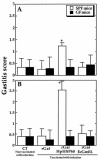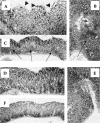Effect of bacterial flora on postimmunization gastritis following oral vaccination of mice with Helicobacter pylori heat shock protein 60
- PMID: 12965909
- PMCID: PMC193875
- DOI: 10.1128/cdli.10.5.808-812.2003
Effect of bacterial flora on postimmunization gastritis following oral vaccination of mice with Helicobacter pylori heat shock protein 60
Abstract
In order to assess the efficacy of oral Helicobacter pylori heat shock protein 60 (HSP60) as a vaccine, protection against H. pylori infection in specific-pathogen-free (SPF) C57BL/6 and germfree (GF) IQI mice was examined. Prophylactic oral vaccination of these two strains of mice with either H. pylori HSP60 or Escherichia coli GroEL inhibited H. pylori colonization by 90 to 95% at 3 weeks postinfection (p.i.). However, these mice were only partially protected because bacterial loads increased in all animals at 10 weeks p.i. Anti-H. pylori HSP60 immunoglobulin G was detected in serum at 3 weeks p.i. in mice vaccinated with either H. pylori HSP60 or GroEL. Significant increases in the gastritis scores were observed only in SPF mice immunized with H. pylori HSP60. These results indicate that oral vaccination with H. pylori HSP60 has partial protective effects on subsequent H. pylori infection but also induces postimmunization gastritis. However, GF mice immunized with H. pylori HSP60 did not suffer from severe gastritis. Therefore, the presence of bacterial flora appears to contribute to the induction of postimmunization gastritis.
Figures




Similar articles
-
Local secretory immunoglobulin A and postimmunization gastritis correlate with protection against Helicobacter pylori infection after oral vaccination of mice.Infect Immun. 1999 May;67(5):2531-9. doi: 10.1128/IAI.67.5.2531-2539.1999. Infect Immun. 1999. PMID: 10225917 Free PMC article.
-
Oral Immunization with a Multivalent Epitope-Based Vaccine, Based on NAP, Urease, HSP60, and HpaA, Provides Therapeutic Effect on H. pylori Infection in Mongolian gerbils.Front Cell Infect Microbiol. 2017 Aug 4;7:349. doi: 10.3389/fcimb.2017.00349. eCollection 2017. Front Cell Infect Microbiol. 2017. PMID: 28824883 Free PMC article.
-
Effects of oral vaccination and immunomodulation by cholera toxin on experimental Helicobacter pylori infection, reinfection, and gastritis.Infect Immun. 2002 Aug;70(8):4621-7. doi: 10.1128/IAI.70.8.4621-4627.2002. Infect Immun. 2002. PMID: 12117975 Free PMC article.
-
Identification of Helicobacter pylori and the evolution of an efficacious childhood vaccine to protect against gastritis and peptic ulcer disease.Pediatr Res. 2017 Jan;81(1-2):170-176. doi: 10.1038/pr.2016.199. Epub 2016 Oct 4. Pediatr Res. 2017. PMID: 27701380 Review.
-
The role of type-specific antibodies in colonization and infection by Helicobacter pylori.Curr Opin Infect Dis. 2005 Jun;18(3):223-7. doi: 10.1097/01.qco.0000168382.86024.14. Curr Opin Infect Dis. 2005. PMID: 15864099 Review.
Cited by
-
The neglected challenge: Vaccination against rickettsiae.PLoS Negl Trop Dis. 2020 Oct 22;14(10):e0008704. doi: 10.1371/journal.pntd.0008704. eCollection 2020 Oct. PLoS Negl Trop Dis. 2020. PMID: 33091016 Free PMC article. Review.
-
Immunization with the immunodominant Helicobacter suis urease subunit B induces partial protection against H. suis infection in a mouse model.Vet Res. 2012 Oct 26;43(1):72. doi: 10.1186/1297-9716-43-72. Vet Res. 2012. PMID: 23101660 Free PMC article.
-
GroEL is an immunodominant surface-exposed antigen of Rickettsia typhi.PLoS One. 2021 Jun 10;16(6):e0253084. doi: 10.1371/journal.pone.0253084. eCollection 2021. PLoS One. 2021. PMID: 34111210 Free PMC article.
-
Long-term infection of Mongolian gerbils with Helicobacter pylori: microbiological, histopathological, and serological analyses.Clin Diagn Lab Immunol. 2005 Feb;12(2):347-53. doi: 10.1128/CDLI.12.2.347-353.2005. Clin Diagn Lab Immunol. 2005. PMID: 15699432 Free PMC article.
-
Helicobacter felis--associated gastric disease in microbiota-restricted mice.J Histochem Cytochem. 2011 Sep;59(9):826-41. doi: 10.1369/0022155411416242. J Histochem Cytochem. 2011. PMID: 21852692 Free PMC article.
References
-
- Cario, E., I. M. Rosenberg, S. L. Brandwein, P. L. Beck, H. C. Reinecker, and D. K. Podoisky. 2000. Lipopolysaccharide activates during signaling pathways in intestinal epithelial cell lines expressing Toll-like receptors. J. Immunol. 164:443-451. - PubMed
-
- Chen, W., D. Shu, and V. S. Chadwick. 1999. Helicobacter pylori infection in interleukin-4-deficient and transgenic mice. Scand. J. Gastroenterol. 34:987-992. - PubMed
-
- Del Giudice, G., A. Covacci, J. L. Telford, C. Montecucco, and R. Rappuoli. 2001. The design of vaccines against Helicobacter pylori and their development. Annu. Rev. Immunol. 19:523-563. - PubMed
MeSH terms
Substances
LinkOut - more resources
Full Text Sources
Other Literature Sources
Medical
Research Materials
Miscellaneous

